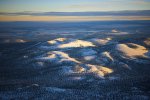Dogpilot
Well-Known Member
Everybody has an opinion. I have been doing photography as an adjunct to my profession as a geologist for decades now. I do extensive photography from actual aircraft. Drones are cool for my work in certain areas, especially if the transit is too long to justify a flight to photographs certain elements. My aircraft costs several hundred an hour to operate, so the drone fills the gap. I have no opinion on the ND filters, since I never do video. I do use polarizers a lot, unless it is too dim outside that the 1 stop the polarizers lowers my shutter speed by, too much and I get resulting smear.
Polarizers are essential for haze reduction. Haze is generally reflected light in the upper blue spectrum. When it is reflected it picks up a polarization, which you can use your polarizer to cut off some of it (you have to rotate it to see best effect for that direction). When you are looking down the effect of haze is increased, since generally, the sun is above us. You can see this by just looking around in a circle and seeing one quadrant is always hazier than the others. This is the reflected polarized blue light.
I even have a Mavic 2 Pro that I modified for full spectrum. I have a pile of differing wavelength pass filters I use on it, depending on what I am looking for. I have the same in my DSLR's, which I have two modified for the same work from the aircraft.
So, my conclusion, your milage may vary, is that at least the polarizer is an essential filter when shooting from the air and in different directions. I do like the enhancement of colors and increased contrast as well.
I do take a photo or two for esthetics as well. Notice the haze is much reduced and the colors are enhanced with more pleasing contrast. This is from an aircraft, not a drone.

Polarizers are essential for haze reduction. Haze is generally reflected light in the upper blue spectrum. When it is reflected it picks up a polarization, which you can use your polarizer to cut off some of it (you have to rotate it to see best effect for that direction). When you are looking down the effect of haze is increased, since generally, the sun is above us. You can see this by just looking around in a circle and seeing one quadrant is always hazier than the others. This is the reflected polarized blue light.
I even have a Mavic 2 Pro that I modified for full spectrum. I have a pile of differing wavelength pass filters I use on it, depending on what I am looking for. I have the same in my DSLR's, which I have two modified for the same work from the aircraft.
So, my conclusion, your milage may vary, is that at least the polarizer is an essential filter when shooting from the air and in different directions. I do like the enhancement of colors and increased contrast as well.
I do take a photo or two for esthetics as well. Notice the haze is much reduced and the colors are enhanced with more pleasing contrast. This is from an aircraft, not a drone.












